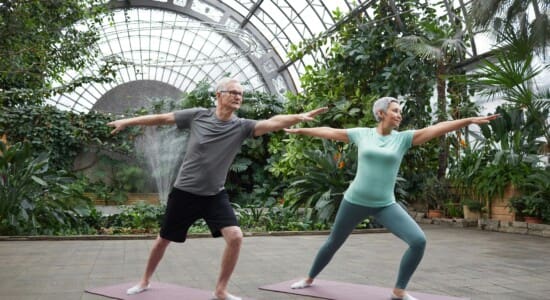
Most people associate aging with muscle loss or lower metabolism. But balance, the simple ability to remain stable on your feet, is emerging as one of the most powerful predictors of long-term health. In fact, recent research shows that your ability to balance on one leg for just 10 seconds can predict your risk of falling, hospitalization, and even death.
More importantly, balance plays a critical role in brain health. For adults over 50, it may also signal early warning signs of cognitive decline or Alzheimer’s disease. Let’s break down the science and explain how simple balance training can support longevity, mobility, and mental sharpness.
Balance Is a Predictor of Longevity
Balance assessments are now being used in clinical settings to help determine overall health risk. One large study found that adults over 50 who could not balance on one leg for 10 seconds had nearly double the risk of mortality within the following decade compared to those who could (1). Poor balance is also associated with a higher likelihood of hospitalization, falls, and decreased functional independence (2).
That means balance isn’t just about coordination. It’s a snapshot of your neuromuscular and cognitive integrity.
💡 Key Takeaway: Your ability to stay balanced reflects far more than just coordination—it may be a powerful signal of your long-term health and mortality risk.
Stability and Strength Go Hand in Hand
As you age, you naturally lose muscle, especially fast-twitch fibers needed for quick reactions. This muscle loss can lead to poor postural control, delayed reaction times, and increased fall risk.
This decline contributes to poor postural control, slower reaction times, and a higher risk of falling. Importantly, poor balance and strength are strongly tied to increased fear of falling, which is a key predictor of reduced confidence, limited mobility, and social withdrawal. Fortunately, improving muscle strength and stability through regular physical activity can reduce both fall risk and fear, leading to greater independence and significantly improved psychological well-being (3).
The good news is that combining resistance training with balance-focused movements enhances both outcomes. Exercises like step-ups, squats, and Tai Chi have been shown to boost balance confidence and reduce fall risk (4, 5).
💡 Key Takeaway: Combining strength and balance training is one of the most effective ways to reduce fall risk and support healthy aging.
Better Balance Means a Better Brain
Balance training doesn’t just help your muscles. It also improves your brain. Neuroimaging studies show that structured balance practice increases gray matter density in key areas related to memory, spatial awareness, and executive function, including the hippocampus and prefrontal cortex (6). These regions are among the first to deteriorate in Alzheimer’s disease.
In one study, 12 weeks of balance training significantly boosted brain-derived neurotrophic factor (BDNF), a protein that supports neuron growth and cognitive resilience (7). Higher levels of BDNF have been linked to improved learning, memory, and protection against neurodegenerative disorders.
💡 Key Takeaway: Balance training helps preserve and even enhance brain structure and function, protecting against cognitive decline.
Poor Balance May Signal Cognitive Decline
Impairments in balance and walking speed are strong predictors of brain atrophy and cognitive decline in older adults, highlighting the link between physical and neurological health (8).
Even more concerning, older adults with Alzheimer’s fall twice as often as those without it. And because their motor planning and recovery mechanisms are slower, these falls often lead to more serious injuries, hospitalizations, and accelerated mental decline (9).
💡 Key Takeaway: Declining balance may be one of the earliest signs of cognitive impairment—and a serious red flag for future decline.
How to Train Balance Daily
You don’t need fancy equipment to improve your balance. What matters is consistency and variety. Here are a few research-backed ways to add balance training to your routine:
- One-Leg Balance Test: Stand on one leg for 10 seconds. Try to build up to 30 seconds per side.
- Heel-to-Toe Walking: Walk in a straight line placing one foot directly in front of the other for 20 steps.
- Supported Squats: Hold a sturdy object and perform 5–10 shallow squats to build leg strength and coordination.
- Stability Ball Sitting: Sit on a stability ball for 30–60 seconds to challenge your core and posture.
- Cognitive-Motor Drills: Combine movement with thinking, such as reciting words or counting backwards while walking.
- Tai Chi or Yoga: Gentle flow practices help improve spatial awareness, joint control, and mental focus.
These small, daily practices can improve both your physical stability and mental sharpness over time.
💡 Key Takeaway: Daily balance drills don’t take much time but can have a major impact on coordination, cognitive performance, and injury prevention.
✏︎ The Bottom Line
Balance is more than just a physical skill. It’s a reflection of your muscular strength, neurological function, and even cognitive health. As research shows, poor balance is linked to a higher risk of falls, disease, and even early death. But the right training approach can slow aging, improve brain function, and keep you moving with confidence for years to come.
If you’re serious about optimizing longevity and staying sharp into your 50s, 60s, and beyond, don’t overlook the importance of balance.
Ready to rebuild strength and stability from the ground up?
Start with the 10 Weight Loss Myths That Are Keeping You Stuck—And How to Break Free free guide. It’s your first step toward smarter training and lasting results.
References
- Araujo, Claudio Gil et al. “Successful 10-second one-legged stance performance predicts survival in middle-aged and older individuals.” British journal of sports medicine vol. 56,17 (2022): 975-980. doi:10.1136/bjsports-2021-105360. https://pubmed.ncbi.nlm.nih.gov/35764003
- Chu, Leung-Wing et al. “Impact of falls on the balance, gait, and activities of daily living functioning in community-dwelling Chinese older adults.” The journals of gerontology. Series A, Biological sciences and medical sciences vol. 61,4 (2006): 399-404. doi:10.1093/gerona/61.4.399. https://pubmed.ncbi.nlm.nih.gov/16611708/
- Netz, Yael et al. “Physical activity and psychological well-being in advanced age: a meta-analysis of intervention studies.” Psychology and aging vol. 20,2 (2005): 272-84. doi:10.1037/0882-7974.20.2.272. https://pubmed.ncbi.nlm.nih.gov/16029091/
- Liu-Ambrose, Teresa et al. “Resistance and agility training reduce fall risk in women aged 75 to 85 with low bone mass: a 6-month randomized, controlled trial.” Journal of the American Geriatrics Society vol. 52,5 (2004): 657-65. doi:10.1111/j.1532-5415.2004.52200.x. https://pubmed.ncbi.nlm.nih.gov/16029091/
- Bubela, Deborah et al. “Balance and Functional Outcomes for Older Community-Dwelling Adults Who Practice Tai Chi and Those Who Do Not: A Comparative Study.” Journal of geriatric physical therapy (2001) vol. 42,4 (2019): 209-215. doi:10.1519/JPT.0000000000000153. https://pubmed.ncbi.nlm.nih.gov/29135600/
- Taubert, Marco, et al. “Dynamic “ Properties of Human Brain Structure: Learning-Related Changes in Cortical Areas and Associated Fiber Connections”The Journal of Neuroscience, vol. 30, no. 35, 2010, pp. 11670–11677. https://www.jneurosci.org/content/30/35/11670
- Szuhany, Kristin L et al. “A meta-analytic review of the effects of exercise on brain-derived neurotrophic factor.” Journal of psychiatric research vol. 60 (2015): 56-64. doi:10.1016/j.jpsychires.2014.10.003. https://pubmed.ncbi.nlm.nih.gov/25455510/
- Beauchet, Olivier et al. “Poor Gait Performance and Prediction of Dementia: Results From a Meta-Analysis.” Journal of the American Medical Directors Association vol. 17,6 (2016): 482-90. doi:10.1016/j.jamda.2015.12.092. https://pubmed.ncbi.nlm.nih.gov/26852960/
- Kehrer-Dunlap, Abigail L et al. “Falls and Alzheimer Disease.” Advances in geriatric medicine and research vol. 6,1 (2024): e240001. doi:10.20900/agmr.20240001. https://pubmed.ncbi.nlm.nih.gov/38549879/




